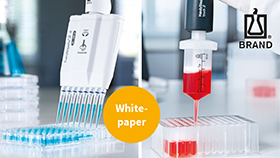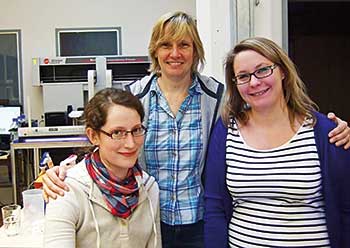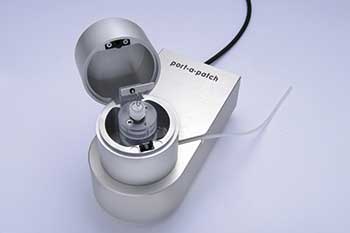Making a Career in Biophysics
Career strategies for young European scientists
Interview by Karin Hollricher, Labtimes 02/2014
There’s also a successful professional life for scientists outside of academia. Biophysicist, Andrea Brüggemann, is the Chief Science Officer at Nanion, a company specialising in the development of electrophysiology devices. She spoke with Karin Hollricher about her passion for her work and her enthusiasm for her job.
The most famous biophysical achievement was perhaps revealing the structure of the DNA molecule. As the Biophysical Society writes on their homepage, biophysicists ask questions, such as “How do protein machines work?” and “How do nerve cells communicate?”. Andrea Brüggemann, who classes herself as a biophysicist, asks “How do ion channels work?” Although she is just 47 years old, she can already look back on a gripping scientific and professional life that has always pivoted around solving biological questions by physical means. She focussed on working with ion channels – now as CSO at Nanion, a 2002 founded company situated in the centre of Munich. We talked about how and why one would become a biophycisist – then and today.
A soon-to-be student who wants to study biophysics will be really astonished: there are hardly any bachelor degree courses in biophysics, at least not here in Germany. So, this student has the choice: biology or physics – what would be your advice?
Andrea Brüggemann: I think he or she should study physics because it’s easier to learn biology than physics from textbooks.
So, you would not employ a graduate with a Master in biology?
Brüggemann: Sure, we would. But you would find it easier if you are a physicist because studying ion channels means measuring currents. You have to understand not only the biological system but also the physical background. And you have to work with a lot of technical devices. Nevertheless, the members of our team have different backgrounds: some studied physics; others got an education in biology, chemistry or pharmacy but also in engineering.
When you started out studying physics at the University of Bochum in Germany did you have biological applications already in mind?
Brüggemann: No, not at all. I first studied physics and philosophy only and then, out of curiosity, I looked into physical chemistry. But I didn’t find that much exciting. So, I tried biochemistry and that was fantastic. It was closer to what scientists really did in the lab at that time, like isolation of DNA. The physics lectures and practical courses were often only comprised of historical experiments, such as measuring the speed of light.
But these experiments do work, even in undergraduate courses.
Brüggemann: (laughs) That’s absolutely right. But I found it kind of boring. I recently had a student who learned, in material sciences, how to take a laser apart, put it together and adjust it to different wavelengths. That’s so much fun and it’s what scientists in the field really need to know. There was nothing like that when I studied physics in the early 1990s. Olaf Pongs, a professor at Bochum University at that time, offered me the possibility to do a diploma thesis characterising a potassium ion channel. He was a lecturer and one of the first to clone the gene for a potassium ion channel. He sent me to Göttingen where I could learn the patch clamp technique in the lab of Erwin Neher. Luckily, that work ended up in a Nature paper (365(6445):445-8). I liked working on ion channels so much that I stayed in Göttingen and continued my PhD with Walter Stühmer at the Max Planck Institute of Experimental Medicine.
You studied physics but you did your diploma thesis in molecular biology in combination with electrophysiology? How did you convince the representatives of two departments to agree on that at a time when disciplines were still very separate?
Brüggemann: I was lucky to meet a very encouraging and interested Dean at Bochum University, who made it possible for me to do both, first the diploma thesis and then my PhD in Physics, though my thesis was closer-related to Biochemistry and Biophysics.
Think back to the end of your PhD, a momentous time in every PhD student’s life: did you want to stay with academic science or did you favour a job in industry?
Brüggemann: Actually, I was planning to do a postdoc in Italy but I was offered a job at Hoechst, which is today Sanofi Aventis. I wasn’t sure whether I would like working in industry. So, I called the professor in Italy and explained my situation. And he said: Well, try industry. And if you don’t like it, you can still come to our lab.
That’s a surprisingly exceptional answer to a young, inexperienced postdoc. So what happened?
Brüggemann: I stayed in industry for a while. We analysed the influence of molecules and drugs on ion channels and tested if any would improve heart function. I made quite a distinguished career but I didn’t like my day-to-day work too much. I couldn’t do any lab work but had to do a lot of administrative work and give one presentation after another. Also, my job got very political and I thought: hey, this is really a great job but it is not the job for me.
So you left that presumably very well-paid position?
Brüggemann: Indeed, and I got an even better paid position at a small company in Lausanne. Cytion designed automated patch clamp devices. There, though being one of the company leaders, I was able to do experiments in the lab. Unfortunately, we were too successful, being bought by Molecular Devices, who later closed down the company. But again, I was lucky and had met Michael and Niels Fertig. Nanion was founded just a year earlier by Niels and others. They were the first employees and owners.
Did you earn even more money?
Brüggemann: No, not at all. I had a quite low salary then – but a bright future [she grins broadly]. Though I didn’t reach my Lausanne level until now; for me it’s more important to have interesting work. Well, as long as I have enough for making a living and some holidays. And then there’s our great company social life: we have table tennis and a kicker upstairs, a great roof terrace for barbeque, Bavarian beer, pasta and sauce for those who work late, and always a box of Kinderschokolade.
That sounds like your company is a second home. As I understood, you were lucky and on several occasions you took advantage of an opportunity. Again, I’m asking for students’ advice: What if there is no obvious opportunity?
Brüggemann: There will be. Just mind some conditions. It’s absolutely important to have a passion for what you do. It makes a lot of sense to work in a field that’s not old fashioned or about to perish but a field that’s just starting out; like the work on ion channels at that time.
Well, it was 1982, when the first ion channel gene was cloned and in 1984 the first channels were expressed in foreign cells.
Brüggemann: Yes, and Neher had just gotten the Nobel Prize.
...in 1991 for measuring currents of single ion channels with patch clamp...
Brüggemann: Yes. And at that time there was also an ion channel group in Bochum. The Professor, Olaf Pongs, was in his 40s or so and very connected to his students. He was very open to trying new things.
For example, asking a physicist with no training in molecular biology to clone a potassium channel?
Brüggemann: Sure, for me as a physicist it’s not routine to clone an ion channel gene. But I was open to learn and to do it, and to broaden my skills. I have been like that my whole scientific life but I was always focussed on ion channels. So, in that field I did everything: clone the gene, express it in cells, work with the cells, do electrophysiological studies using different techniques. I gained a very wide technological background. Then I worked at the university, at a Max Planck Institute, in big industry and with a small enterprise. Also, I did courses, such as safety in gene technology and first aid, etc.
Was the course in biological safety of any use later?
Brüggemann: Indeed. When we were only three people at Nanion and we had to apply for an S1 laboratory. I, as an officer for biological safety, was able to do so. I did everything that I thought could be useful at some point. That’s what I would recommend doing: explore as many things as possible around the issue you are focussed on.
Okay, ion channels are not literally about to perish but working on them is kind of established. So, which fields do you identify as brand new and promising for young scientists; what issues should they consider?
Brüggemann: Through the eyes of a physicist, who wants to work with biological material, I’d say the whole field of nanotechnology, microfluidics, two-photon-microscopy, atomic force microscopy.
Atomic force microscopy is old hat.
Brüggemann: But atomic force microscopy on cells is still not an easy task. Anyway, perhaps one should check out a volume of Nature to learn what’s new. Concerning the biological part of the topic, I’d see issues regarding diseases to have a promising future. Also, application in diseases makes a good argument in grant applications. Nanotechnology, on the other hand, may be useful for protection of the environment or for saving energy.
Before we now discuss how I could make a career at Nanion, please first explain what this company sells.
Brüggemann: We develop high throughput patch clamp instruments. In the early days, you had to patch a cell or ion channel with a micropipette that was so tiny, you needed the help of a microscope and manipulators. There was no way of automising that kind of experiment. We use a chip – made from borosilicate glass, the same material as the micropipettes. In that we drill holes with shapes very similar to micropipettes. Since we’re now working on a planar surface, we can do the experiment on a microtitre plate. So, we suspend cells in solution, add them to the chip and then we apply suction, so that a single cell will be fixed right above the pipette hole. The rest is washed away. Two electrodes on top and at the bottom of the chip are applied, and then we can measure changes in ion channel current.
Here, some words about Nanion’s history seem appropriate.
Brüggemann: The company was founded in 2002 and we started with the development of a single chip device, a very small benchtop instrument that is patch clamp without manipulators – very easy. Then we designed a robot-based instrument that can prepare and execute eight experiments at a time. After that, we built a device for a 96-well plate and our new layout is a 384-well plate. That is compatible with standard high throughput screening, which is of big interest for the pharma industry. Besides industrial applications, we try to stay very close to science, to what is interesting and new in the field. One example: When we realised that scientists were interested in working with sodium channels because they turned out to be important for pain research, we arranged a cooperation to measure them here with our instruments. For doing this application work, we have a team of electrophysiologists.
Mostly male physicists, I suppose?
Brüggemann: (obviously amused at my assumption) Actually, you are completely wrong. Our electrophysiology team is dominated by women. In the beginning there were only female PhDs, two physicists, one chemist and one biologist. Now, there are seven women and four men.
That’s quite unusual.
Brüggemann: Well, we have the feeling that women are often more sociable and that’s one of the most important qualities you need, to acquire new customers and to take care of our existing clients.
If I’d like to learn more about planar patch clamp or the work at Nanion, what should I do?
Brüggemann: Well, I guess 90% of people at Nanion already did their diploma thesis with us. Not so much in electrophysiology. We hired them directly after their PhD. We have cooperations with the four universities in Munich and get Master and Bachelor students from them. They get to know us and the work done here, and we get to know them. We are now some 50 people here and will be growing slowly with the demand. Hopefully not too much (smiles).
But Nanion did grow recently; it even bought a company, IonGate Biosciences.
Brüggemann: That’s right, two years ago we bought IonGate. The funny thing is: I was one of IonGate’s founders. So it’s a kind of homecoming. This company did service on ion channels, especially hERG, a potassium channel that causes arrhythmic events when it is blocked. Because some drugs interact with hERG, leading to severe side effects, the US Food and Drug Administration, FDA, has withdrawn quite a number of them already on the market, such as antihistamines, antibiotics and anti-depressants. Now, every new drug has to be tested for its action on hERG before it gets approval by the FDA. When the FDA set up that rule, I was working for Hoechst and thought it might be a good business idea for a company to sell service on hERG measurements. That was the founding idea of IonGate. Besides service, the company developed a technology that allows the measurement of transport proteins. They are very difficult to measure. This technology fits well to our portfolio and now we are able to put the SURFE2R technology on the backbone of our Synchropatch 96. It runs with the same hardware and software but has a different kind of measurement.
Now, looking back on your career: you always wanted to work in the lab and are now CSO of a middle-sized biotech company. What do you like more?
Brüggemann: My speciality is hands on, definitely. I always loved doing experiments and it’s still so. In the beginning, when Niels, Michael George and me were the only three, we had to decide, who would do what job. Niels said: Andrea, you are the most senior, the most experienced person in our little team. You should be the CEO. And I replied: never ever. I feel myself more as a CSO. So Niels, who had just finished his PhD, became our CEO – and he really enjoyed this job and is still doing so. And Michael was happy to become CTO – Technical Officer. Looking back, these were the right decisions. We are all working in the positions we like the most. And personally, I was in the lab every day last year while we tested our 384-well system. So, there’s no reason to complain, I love my work.
Last Changed: 21.03.2014








